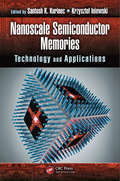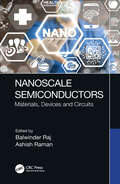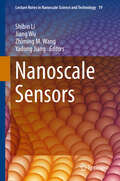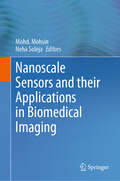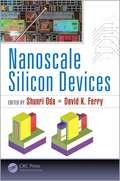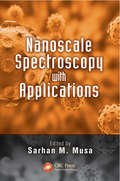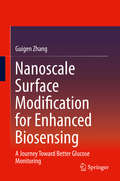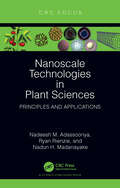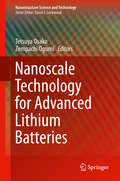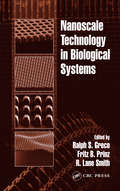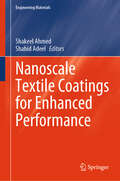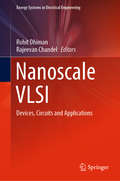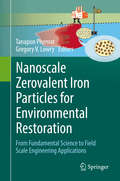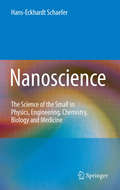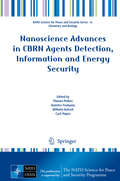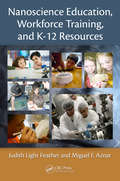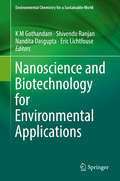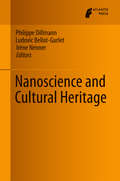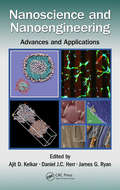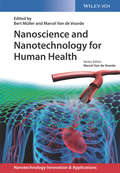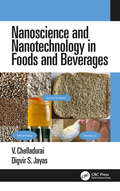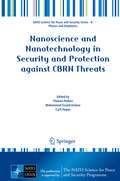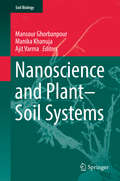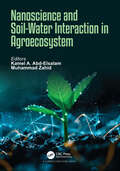- Table View
- List View
Nanoscale Semiconductor Memories: Technology and Applications (Devices, Circuits, and Systems #24)
by Krzysztof Iniewski Santosh K. KurinecNanoscale memories are used everywhere. From your iPhone to a supercomputer, every electronic device contains at least one such type. With coverage of current and prototypical technologies, Nanoscale Semiconductor Memories: Technology and Applications presents the latest research in the field of nanoscale memories technology in one place. It also covers a myriad of applications that nanoscale memories technology has enabled. The book begins with coverage of SRAM, addressing the design challenges as the technology scales, then provides design strategies to mitigate radiation induced upsets in SRAM. It discusses the current state-of-the-art DRAM technology and the need to develop high performance sense amplifier circuitry. The text then covers the novel concept of capacitorless 1T DRAM, termed as Advanced-RAM or A-RAM, and presents a discussion on quantum dot (QD) based flash memory. Building on this foundation, the coverage turns to STT-RAM, emphasizing scalable embedded STT-RAM, and the physics and engineering of magnetic domain wall "racetrack" memory. The book also discusses state-of-the-art modeling applied to phase change memory devices and includes an extensive review of RRAM, highlighting the physics of operation and analyzing different materials systems currently under investigation. The hunt is still on for universal memory that fits all the requirements of an "ideal memory" capable of high-density storage, low-power operation, unparalleled speed, high endurance, and low cost. Taking an interdisciplinary approach, this book bridges technological and application issues to provide the groundwork for developing custom designed memory systems.
Nanoscale Semiconductors: Materials, Devices and Circuits
by Balwinder Raj Ashish RamanThis reference text discusses conduction mechanism, structure construction, operation, performance evaluation and applications of nanoscale semiconductor materials and devices in VLSI circuits design.The text explains nano materials, devices, analysis of its design parameters to meet the sub-nano-regime challenges for CMOS devices. It discusses important topics including memory design and testing, fin field-effect transistor (FinFET), tunnel field-effect transistor (TFET) for sensors design, carbon nanotube field-effect transistor (CNTFET) for memory design, nanowire and nanoribbons, nano devices based low-power-circuit design, and microelectromechanical systems (MEMS) design.The book discusses nanoscale semiconductor materials, device models, and circuit design covers nanoscale semiconductor device structures and modeling discusses novel nano-semiconductor devices such as FinFET, CNTFET, and Nanowire covers power dissipation and reduction techniques Discussing innovative nanoscale semiconductor device structures and modeling, this text will be useful for graduate students, and academic researchers in diverse areas such as electrical engineering, electronics and communication engineering, nanoscience, and nanotechnology. It covers nano devices based low-power-circuit design, nanoscale devices based digital VLSI circuits, and novel devices based analog VLSI circuits design.
Nanoscale Sensors
by Zhiming M. Wang Jiang Wu Shibin Li Yadong JiangThis book is a comprehensive introduction to nanoscale materials for sensor applications, with a focus on connecting the fundamental laws of physics and the chemistry of materials with device design. Nanoscale sensors can be used for a wide variety of applications, including the detection of gases, optical signals, and mechanical strain, and can meet the need to detect and quantify the presence of gaseous pollutants or other dangerous substances in the environment. Gas sensors have found various applications in our daily lives and in industry. Semiconductive oxides, including SnO2, ZnO, Fe2O3, and In2O3, are promising candidates for gas sensor applications. Carbon nanomaterials are becoming increasingly available as "off-the-shelf" components, and this makes nanotechnology more exciting and approachable than ever before. Nano-wire based field- effect transistor biosensors have also received much attention in recent years as a way to achieve ultra-sensitive and label-free sensing of molecules of biological interest. A diverse array of semiconductor-based nanostructures has been synthesized for use as a photoelectrochemical sensor or biosensor in the detection of low concentrations of analytes. A novel acoustic sensor for structural health monitoring (SHM) that utilizes lead zirconate titanate (PZT) nano- active fiber composites (NAFCs) is described as well.
Nanoscale Sensors and their Applications in Biomedical Imaging
by Mohd. Mohsin Neha SolejaThe book offers a comprehensive exploration of cutting-edge nano-sensor technologies and their critical role in the field of biomedicine. This book covers a diverse range of topics, from fluorescence-based nanosensors that detect and quantify nanovesicles at the nanoscale to the recent advances in nano biosensors for agriculture and health applications. It provides valuable insights into the green synthesis of silver nanoparticles and their biomedical applications, highlighting eco-friendly approaches to nanomaterial production. The use of FRET-based tools for real-time quantification of vitamins and bioimaging is also extensively discussed, presenting innovative techniques for analysis. The book further delves into the potential of nanosensors in medicine, exploring the characteristic features that make them promising candidates for various medical applications. It also covers the application of fluorescent biosensors for intracellular signalling analysis, paving the way for understanding complex cellular processes. The book also discusses the use of nanosensors for monitoring blood clotting disorders, offering new possibilities for diagnostic and therapeutic interventions. It also presents fluorescent probes for detecting gas transmitters, such as H2S, CO, and NO, which have significant implications in the field of gas sensing and medical research. It serves as a valuable resource for researchers, scientists, and professionals in the fields of nanotechnology, biotechnology, and medicine, offering ground-breaking insights into the rapidly evolving world of nano sensors and their significant impact on healthcare and diagnostics.
Nanoscale Silicon Devices
by David K. Ferry Shunri OdaIs Bigger Always Better? Explore the Behavior of Very Small Devices as Described by Quantum MechanicsSmaller is better when it comes to the semiconductor transistor. Nanoscale Silicon Devices examines the growth of semiconductor device miniaturization and related advances in material, device, circuit, and system design, and highlights the use of device scaling within the semiconductor industry. Device scaling, the practice of continuously scaling down the size of metal-oxide-semiconductor field-effect transistors (MOSFETs), has significantly improved the performance of small computers, mobile phones, and similar devices. The practice has resulted in smaller delay time and higher device density in a chip without an increase in power consumption. This book covers recent advancements and considers the future prospects of nanoscale silicon (Si) devices. It provides an introduction to new concepts (including variability in scaled MOSFETs, thermal effects, spintronics-based nonvolatile computing systems, spin-based qubits, magnetoelectric devices, NEMS devices, tunnel FETs, dopant engineering, and single-electron transfer), new materials (such as high-k dielectrics and germanium), and new device structures in three dimensions. It covers the fundamentals of such devices, describes the physics and modeling of these devices, and advocates further device scaling and minimization of energy consumption in future large-scale integrated circuits (VLSI).Additional coverage includes: Physics of nm scaled devices in terms of quantum mechanics Advanced 3D transistors: tri-gate structure and thermal effects Variability in scaled MOSFET Spintronics on Si platform NEMS devices for switching, memory, and sensor applications The concept of ballistic transport The present status of the transistor variability and more An indispensable resource, Nanoscale Silicon Devices serves device engineers and academic researchers (including graduate students) in the fields of electron devices, solid-state physics, and nanotechnology.
Nanoscale Spectroscopy with Applications
by Sarhan M. MusaThis book introduces the key concepts of nanoscale spectroscopy methods used in nanotechnologies in a manner that is easily digestible for a beginner in the field. It discusses future applications of nanotechnologies in technical industries. It also covers new developments and interdisciplinary research in engineering, science, and medicine. An overview of nanoscale spectroscopy for nanotechnologies, the book describes the technologies with an emphasis on how they work and on their key benefits. It also serves as a reference for veterans in the field.
Nanoscale Surface Modification for Enhanced Biosensing
by Guigen ZhangThis book gives a comprehensive overview of electrochemical-based biosensors and their crucial components. Practical examples are given throughout the text to illustrate how the performance of electrochemical-based biosensors can be improved by nanoscale surface modification and how an optimal design can be achieved. All essential aspects of biosensors are considered, including electrode functionalization, efficiency of the mass transport of reactive species, and long term durability and functionality of the sensor. This book also: · Explains how the performance of an electrochemical-based biosensor can be improved by nanoscale surface modification · Gives readers the tools to evaluate and improve the performance of a biosensor with a multidisciplinary approach that considers electrical, electrostatic, electrochemical, chemical, and biochemical events · Links the performance of a sensor to the various governing physical and chemical principles so readers can fully understand how a biosensor with nanoscale modified electrode surface functions.
Nanoscale Technologies in Plant Sciences: Principles and Applications
by Nadeesh M. Adassooriya Ryan Rienzie Nadun H. MadanayakeThis book provides a detailed review on the interactions of nanomaterials with plants, nanodelivery systems in agriculture, the impacts of nanomaterials on seed germination, nanosensors for plant disease diagnosis and toxicity aspects of nanomaterials towards plants. In addition, nanomaterials synthesis and nanomaterials characterisation techniques, are discussed. This book also highlights practical aspects related to these subsections. The content of this text will help a diverse group of researchers to apply nanotechnology concepts in life sciences. Although there are numerous books available on the subject, they mostly discuss recent research findings and very few covers the fundamentals and applications. This book will be advantageous for budding scientists who are interested in the field of plant nanomaterial interactions. It is obvious that current literature on nanotechnology has a bias towards chemistry and physics which creates a barrier for biologists to pursue nanosciences. This book attempts to address the aforementioned challenge.
Nanoscale Technology for Advanced Lithium Batteries
by Tetsuya Osaka Zempachi OgumiThe unfortunate and serious accident at the nuclear power plants in Fukushima, Japan caused by the earthquake and tsunami in March 2011 dealt Japan a serious blow. Japan was nearly deprived of electric power when in response to the accident all nuclear reactors in Japan were shut down. This shortage further accelerated the introduction of renewable energies. This book surveys the new materials and approaches needed to use nanotechnology to introduce the next generation of advanced lithium batteries, currently the most promising energy storage devices available. It provides an overview of nanotechnology for lithium batteries from basic to applied research in selected high technology areas. The book especially focuses on near-term and future advances in these fields. All contributors to this book are expert researchers on lithium batteries.
Nanoscale Technology in Biological Systems
by Fritz B. Prinz Ralph S. Greco R. Lane SmithNanoscale Technology in Biological Systems reviews recent accomplishments in the field of nanobiology and introduces the application of nanoscale matrices to human biology. It focuses on the applications of nanotechnology fabrication to biomedical devices and discusses new physical methods for cell isolation and manipulation and intracellular commu
Nanoscale Textile Coatings for Enhanced Performance (Engineering Materials)
by Shakeel Ahmed Shahid AdeelThis book provides an overview of the latest developments and applications of nanoscale textile coatings. It covers materials used for (creating) these coatings, the different methods of applying them to textiles, and the various ways in which the coatings can improve the performance of the textiles. In addition to providing a technical understanding of the subject, the book also includes case studies and real-world examples of using nanoscale coatings in the textile industry, including areas such as fashion, outdoor gear, and medical textiles. Additionally, the book explores the potential future applications of this technology, as well as the challenges and limitations that need to be overcome in order to bring these innovations to market. This book is a valuable resource for textile engineers, materials scientists, and anyone interested in the exciting field of nanoscale textile coatings. It also addresses the environmental impact of textile coatings and their safety for human use and disposal.
Nanoscale Thermoelectrics
by Xiaodong Wang Zhiming M. WangFor the efficient utilization of energy resources and the minimization of environmental damage, thermoelectric materials can play an important role by converting waste heat into electricity directly. Nanostructured thermoelectric materials have received much attention recently due to the potential for enhanced properties associated with size effects and quantum confinement. Nanoscale Thermoelectrics describes the theory underlying these phenomena, as well as various thermoelectric materials and nanostructures such as carbon nanotubes, SiGe nanowires, and graphene nanoribbons. Chapters written by leading scientists throughout the world are intended to create a fundamental bridge between thermoelectrics and nanotechnology, and to stimulate readers' interest in developing new types of thermoelectric materials and devices for power generation and other applications. Nanoscale Thermoelectrics is both a comprehensive introduction to the field and a guide to further research, and can be recommended for Physics, Electrical Engineering, and Materials Science departments.
Nanoscale VLSI: Devices, Circuits and Applications (Energy Systems in Electrical Engineering)
by Rohit Dhiman Rajeevan ChandelThis book describes methodologies in the design of VLSI devices, circuits and their applications at nanoscale levels. The book begins with the discussion on the dominant role of power dissipation in highly scaled devices.The 15 Chapters of the book are classified under four sections that cover design, modeling, and simulation of electronic, magnetic and compound semiconductors for their applications in VLSI devices, circuits, and systems. This comprehensive volume eloquently presents the design methodologies for ultra–low power VLSI design, potential post–CMOS devices, and their applications from the architectural and system perspectives. The book shall serve as an invaluable reference book for the graduate students, Ph.D./ M.S./ M.Tech. Scholars, researchers, and practicing engineers working in the frontier areas of nanoscale VLSI design.
Nanoscale Zerovalent Iron Particles for Environmental Restoration: From Fundamental Science to Field Scale Engineering Applications
by Tanapon Phenrat Gregory V. LowryThis is the first complete edited volume devoted to providing comprehensive and state-of-the art descriptions of science principles and pilot- and field-scaled engineering applications of nanoscale zerovalent iron particles (NZVI) for soil and groundwater remediation. Although several books on environmental nanotechnology contain chapters of NZVI for environmental remediation (Wiesner and Bottero (2007); Geiger and Carvalho-Knighton (2009); Diallo et al. (2009); Ram et al. (2011)), none of them include a comprehensive treatment of the fundamental and applied aspects of NZVI applications. Most devote a chapter or two discussing a contemporary aspect of NZVI. In addition, environmental nanotechnology has a broad audience including environmental engineers and scientists, geochemists, material scientists, physicists, chemists, biologists, ecologists and toxicologists. None of the current books contain enough background material for such multidisciplinary readers, making it difficult for a graduate student or even an experienced researcher or environmental remediation practitioner new to nanotechnology to catch up with the massive, undigested literature. This prohibits the reader from gaining a complete understanding of NZVI science and technology. In this volume, the sixteen chapters are based on more than two decades of laboratory research and development and field-scaled demonstrations of NZVI implementation. The authors of each chapter are leading researchers and/or practitioners in NZVI technology. This book aims to be an important resource for all levels of audiences, i.e. graduate students, experienced environmental and nanotechnology researchers, and practitioners evaluating environmental remediation, as it is designed to involve everything from basic to advanced concepts.
Nanoscience
by Hans-Eckhardt SchaeferNanoscience stands out for its interdisciplinarity. Barriers between disciplines disappear and the fields tend to converge at the very smallest scale, where basic principles and tools are universal. Novel properties are inherent to nanosized systems due to quantum effects and a reduction in dimensionality: nanoscience is likely to continue to revolutionize many areas of human activity, such as materials science, nanoelectronics, information processing, biotechnology and medicine. This textbook spans all fields of nanoscience, covering its basics and broad applications. After an introduction to the physical and chemical principles of nanoscience, coverage moves on to the adjacent fields of microscopy, nanoanalysis, synthesis, nanocrystals, nanowires, nanolayers, carbon nanostructures, bulk nanomaterials, nanomechanics, nanophotonics, nanofluidics, nanomagnetism, nanotechnology for computers, nanochemistry, nanobiology, and nanomedicine. Consequently, this broad yet unified coverage addresses research in academia and industry across the natural scientists. Didactically structured and replete with hundreds of illustrations, the textbook is aimed primarily at graduate and advanced-undergraduate students of natural sciences and medicine, and their lecturers.
Nanoscience Advances in CBRN Agents Detection, Information and Energy Security
by Wilhelm Kulisch Cyril Popov Plamen Petkov Dumitru TsiulyanuThe preparation and characterization of various nano-scaled materials and their applications in diverse security and safety- related fields. Readers are provided with a broad overview on the topic as it combines articles addressing the preparation and characterization of different nano-scaled materials (metals, oxides, glasses, polymers, carbon-based, etc. ). The contributions derive from the lectures and contributions of the NATO Advanced Study Institute meeting "Nanoscience Advances in CBRN Agents Detection, Information and Energy Security" held in Sozopol, Bulgaria, 29 May - 6 June, 2014. In addition, it presents an interdisciplinary approach, utilizing Nanoscience and Nanotechnology research from different disciplines including; physics, chemistry, engineering, materials science and biology. A major advantage of this book, which represents the knowledge of experts from 20 countries, is the combination of longer papers introducing the basic knowledge on a certain topic, and brief contributions highlighting specific applications in different security areas.
Nanoscience Education, Workforce Training, and K-12 Resources
by Judith Light Feather Miquel F. AznarThe nanotech revolution waits for no man, woman…or child. To revitalize science, technology, engineering, and mathematics (STEM) performance, the U.S. educational system requires a practical strategy to better educate students about nanoscale science and engineering research. This is particularly important in grades K–12, the effective gestation point for future ideas and information. Optimize your use of free resources from the National Science Foundation The first book of its kind, Nanoscience Education, Workforce Training, and K–12 Resources promotes nano-awareness in both the public and private sectors, presenting an overview of the current obstacles that must be overcome within the complex U.S. educational system before any reform is possible. It’s a race against time—and other countries—and the fear is that U.S. students could lag behind for decades, with ineffective teaching and learning methods handicapping their ability to compete globally. Focusing on the application of new knowledge, this concise and highly readable book explores the transdisciplinary nature of nanoscience and its societal impact, also addressing workforce training and risk management. Illustrating the historical perspective of the complexity of K–12 education communities, it defines nanotechnology and evaluates pertinent global and national landscapes, presenting examples of successful change within them. This book is composed of four sections:Foundations—addresses the national educational matrix, exploring the scientific and social implications associated with the delay in adopting nanoscience education in public schoolsTeaching Nanotechnology—discusses the critical process of teaching K–12 students the skills to understand and evaluate emerging technologies they will encounterNanoscience Resources and Programs—provides a wide overview of the resources offered by funded outreach programs from universities with nanoscience centersFramework Applied—analyzes the structure of national government programs and skill level recommendations for nanoeducation from the National Nanotechnology InitiativesThis book offers plans of action and links to sustainable (largely free) development tools to help K–12 students acquire the skills to understand and evaluate emerging technologies. Promoting a holistic teaching approach that encompasses all aspects of science, the authors strive to help readers implement change so that decisions about resources and learning are no longer made "from the top down" by policymakers, but rather "from the bottom up" by teachers, parents, and students at the local level.Akhlesh Lakhtakia, one of the contributors to this volume, was recently featured on CNN in a discussion on solar energy.
Nanoscience and Biotechnology for Environmental Applications (Environmental Chemistry for a Sustainable World #22)
by Eric Lichtfouse Shivendu Ranjan Nandita Dasgupta K M GothandamThis book presents the complete guide for readers to understand the applications, and pros and cons of nanotechnology applications in environmental remediation, although there are few critical reviews and textbooks available on environmental biotechnology. Water pollution has become one of the biggest concerns of the world. After the industrialisation and urbanisation, environmental pollution has become an enormous concern. Water pollution results in biomagnifications by entering the food chain. As a result water pollution and its risks need to be considered seriously and solutions need to be researched. This volume looks into such topics as bioremediation, nanobiotechnology, biosensors, and enzyme degradation to find solutions to these problems.
Nanoscience and Cultural Heritage
by Philippe Dillmann Ludovic Bellot-Gurlet Irène NennerThis book aims to give state of the art in several domains of cultural heritage in which Nanosciences allow fundamental breakthrough. The first part of the book concerns nanostructured materials in ancient artifacts. Understanding their nature and formation processes bring new insight in the apprehension of technical level of ancient societies but can also inspire the design of new materials. The second part is dedicated to the understanding of materials. This crucial issue in material science today, for cultural heritage, needs to perform specific characterization techniques and technologies, but also to create tailored analytical strategies. Part three presents new methods, processes and materials at nano levels that can bring innovative solutions to conservation and restoration issues, linked with the understanding of the alteration processes involved at different scales.
Nanoscience and Nanoengineering: Advances and Applications
by Ajit D. Kelkar James G. Ryan Daniel J.C. HerrReflecting the breadth of the field from research to manufacturing, Nanoscience and Nanoengineering: Advances and Applications delivers an in-depth survey of emerging, high-impact nanotechnologies. Written by a multidisciplinary team of scientists and engineers and edited by prestigious faculty of the Joint School of Nanoscience and Nanoengineering
Nanoscience and Nanotechnology for Human Health
by Marcel Van de Voorde Bert MüllerUnique in combining the expertise of practitioners from university hospitals and that of academic researchers, this timely monograph presents selected topics catering specifically to the needs and interests of natural scientists and engineers as well as physicians who are concerned with developing nanotechnology-based treatments to improve human health. To this end, the book cover the materials aspects of nanomedicine, such as the hierarchical structure of biological materials, the imaging of hard and soft tissues and, in particular, concrete examples of nanotechnology-based approaches in modern medical treatments. The whole is rounded off by a discussion of the opportunities and risks of using nanotechnology and nanomaterials in medicine, backed by case studies taken from real life.
Nanoscience and Nanotechnology in Foods and Beverages
by Vellaichamy Chelladurai Digvir S. JayasPotential applications of nanotechnology in food industry include: encapsulation and delivery of substances in targeted sites, increasing flavor, introducing antibacterial nanoparticles into food, enhancing shelf life, sensing contamination, improved food storage, tracking, tracing, and brand protection. This book provides a basic understanding of the nanoscience and nanotechnology and their applications to different food industry sectors, covering both benefits and drawbacks using nanotechnology in food processing and discussing the development of an international regulatory framework.
Nanoscience and Nanotechnology in Security and Protection against CBRN Threats (NATO Science for Peace and Security Series B: Physics and Biophysics)
by Cyril Popov Plamen Petkov Mohammed Essaid AchourThis book is based on the lectures and contributions of the NATO Advanced Study Institute on “Nanoscience and Nanotechnology in Security and Protection Against CBRN Threats” held in Sozopol, Bulgaria, September 2019. It gives a broad overview on this topic as it combines articles addressing the preparation and characterization of different nanoscaled materials (metals, oxides, glasses, polymers, carbon-based, etc.) in the form of nanowires, nanoparticles, nanocomposites, nanodots, thin films, etc. and contributions on their applications in diverse security and safety related fields. In addition, it presents an interdisciplinary approach drawing on the Nanoscience and Nanotechnology know-how of authors from Physics, Chemistry, Engineering, Materials Science and Biology. A further plus-point of the book, which represents the knowledge of experts from over 20 countries, is the combination of longer papers introducing the background on a certain topic, and brief contributions highlighting specific applications in different security areas.
Nanoscience and Plant–Soil Systems
by Ajit Varma Mansour Ghorbanpour Khanuja ManikaThis book provides in-depth reviews of the effects of nanoparticles on the soil environment, their interactions with plants and also their potential applications as nanofertilizers and pesticides. It offers insights into the current trends and future prospects of nanotechnology, including the benefits and risks and the impact on agriculture and soil ecosystems. Individual chapters explore topics such as nanoparticle biosynthesis, engineered nanomaterials, the use of nanoclays for remediation of polluted sites, nanomaterials in water desalination, their effect on seed germination, plant growth, and nutrient transformations in soil, as well as the use of earthworms as bioremediating agents for nanoparticles. It is a valuable resource for researchers in academia and industry working in the field of agriculture, crop protection, plant sciences, applied microbiology, soil biology and environmental sciences.
Nanoscience and Soil-Water Interaction in Agroecosystem
by Kamel A. Abd-Elsalam Muhammad ZahidThis book discusses how important nanotechnology is for increasing agricultural production through better management of the soil and water. The book looks at how soil characteristics, water retention, and nutrient availability may all be improved by nanoparticles. It draws attention to the use of nanoparticles in precision agriculture as well as their potential for cleaning up polluted soils. The book provides creative answers to problems like water shortages and soil degradation by fusing nanoscience with conventional methods, eventually advancing sustainable farming methods. The significance of nanotechnology in building resilient agroecosystems for future food security is highlighted by this interdisciplinary approach.
